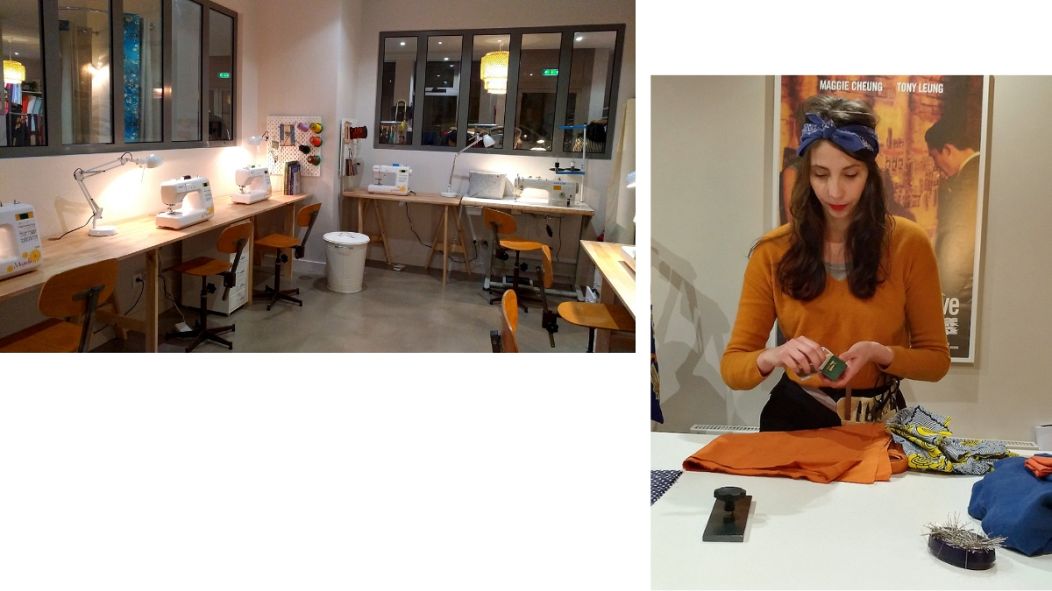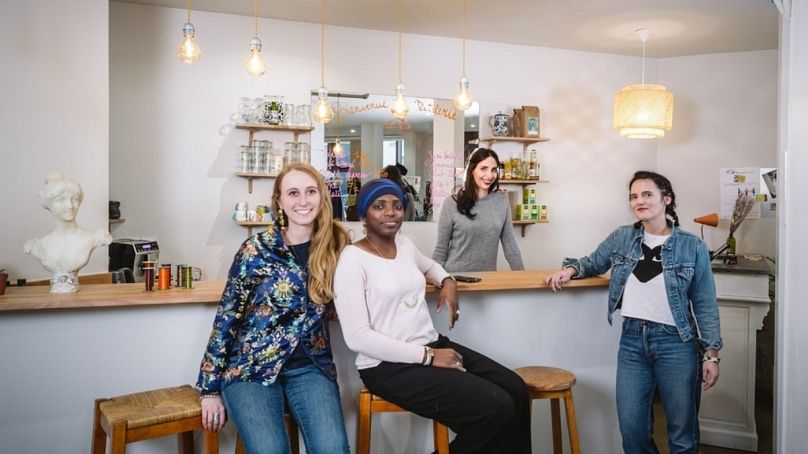A shop, thrift store, haberdashery, sewing workshop, café and a place to recycle pre-loved garments.
On December 10th, English fashion designer Stella McCartney will fly to Katowice in Poland. The reason for her trip? The COP 24, where she will present a United Nations fashion industry charter for climate action. Waste, water pollution, deforestation, manufacturing process toxicity: the English stylist hopes the charter will sound the alarm among the textile industry, one of the most polluting in the world, not to mention its very high social cost for textile workers…
But fighting against textile wastage also means acting on a more local level. At the beginning of 2018, Alice Merle and Elsa Monségur opened La Textilerie, undoubtedly one of the most eco-conscious spots in Paris. At once a store, a thrift store, a haberdashery, a sewing workshop to learn how to fix or reuse old clothes, a café to exchange views on ecological imprint and a place to recycle old stuff, La Textilerie is a unique place in Paris : “Our goal here is to promote an alternative to ready-to-wear clothing, which mass-produces cheap clothes with disastrous social and environmental impact”, says Elsa Monségur.
What do you think is the main issue with the textile industry today?
“One of the sector’s biggest issue relates to overproduction and overconsumption. In France alone, 600 000 tons of clothes are put on the market every year, that is to say, 2,6 billion clothing items. This is kind of crazy, considering we’re only 66 million people in the country! Of these 600 000 tons, approximately 200 000 are given away or redirected towards reuse networks; one can wonder where are the 400 000 other tons going: are they actually worn by people? Waiting in closets or in shops as unsold articles? Or do they simply end up in the trash?
Such production volumes cause different problems. First of all, the over-cultivation of cotton – to the detriment of other kinds of cultivations – leads to very high rates of water consumption. In the same way, high production volumes of polyester mean high consumption of petroleum resources. Then, the fact that mass-produced jeans are sold at a low price contributes to bad work conditions for textile workers. Finally, overproduction and low prices lead us, consumers, to think that clothes aren’t valuable – which means we are able to buy them and wear them twice before throwing them away.”
So, the main purpose of La Textilerie is to make people aware of clothing wastage?
“What we wanted to do was to create an environmentally responsible micro-network around textile. The originality of the concept is that, from the raw material to recycling, the visitor can see the entire clothing item’s life cycle, both upstream and downstream.
Regarding the upstream part, we sell fabric and offer sewing lessons, so that people can learn how to make their own clothes. The fabric is organic and GOTS certified (Global Organic Textile Standards), which means that the cotton was produced according to both organic agriculture and International Labor Organization (ILO) regulation. If people only want to treat themselves or buy a present for someone, that’s fine too: they can visit our thrift store or shop among a selection of eco-conscious fashion designers, who either use organic materials or upcycle old stuff to make their products – like those pillows made from hot-air balloons, advertising banner tarpaulins and recycled polystyrene, for example.
The downstream aspect concerns everything we do here to extend the clothing item’s lifespan. If you don’t wear a sweater, a coat or a pair of trousers anymore, you can come and leave it here: we’ll either sell it to a very reasonable price in our thrift store, so that it can be reused by somebody else, give it away to women living on the streets or sheltered in households, or transform it into new items of clothing in our sewing shop!”
What is the point of showing the entire clothing item’s life cycle?
“This ecosystem has the merit of arousing people’s curiosity about textile issues: each time they come, they ask what is it that we do here, why do we collect clothes, why do we give it away, what do we do during sewing lessons, etc. Every time, those little chats are a way for us to raise awareness about the way we consume clothes.
Sewing lessons are another effective way to raise people’s awareness. When you sew, you realize that making a clothing item takes some time, and if it takes some time, it means that it is valuable. You also start to take an interest in materials: which cotton is that? How was it produced? In which conditions? By who? Once you’ve started to ask yourself those questions, there’s a good chance you won’t keep on consuming clothes the way you did before.”
Did you feel that you met a need when opening La Textilerie?
“Yes, because there was no place like this one in Paris. Each activity – sewing lessons, thrift store, haberdashery, etc. – existed but only separately: we decided to gather them together, so as to create a new kind of place that would allow experimentations around textile.
The public reception has been very positive. People come to La Textilerie every day for many reasons: because they are interested in eco-conscious issues because they want to shop or take sewing lessons because they are from the neighbourhood, or because they just want to sit and have a drink at the bar!”
What kind of events do you offer here?
“We propose a lot of conferences and meetings: we recently held events about raw material – which are the different types of fibres and how to recognize them –, ethical fashion, natural textile dyeing, gender issues, etc.
Textile allows tackling such a large range of issues: economic, industrial, sociological, environmental, health issues… It’s a fascinating subject: the way we consume clothes says a lot about our world and ourselves!”
Writer: Romain Genard













